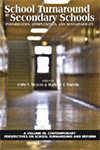
School Turnaround in Secondary Schools
Possibilities, Complexities, & Sustainability
Edited by:
Coby V. Meyers, University of Virginia
Marlene J. Darwin, American Institutes for Research
A volume in the series: Contemporary Perspectives on School Turnaround and Reform. Editor(s): Adam Kho, University of Southern California. Alisha Butler, Wesleyan University. Lam D. Pham, North Carolina State University.
Published 2019
In the continuing quest to turnaround the lowest performing schools, rapid and sustainable reform, or school turnaround, seems most elusive for secondary schools. Secondary schools are rife with challenges due to their wide-ranging mission and organizational complexity. With the continued emphasis on college and career readiness and the vast learning possibilities enhanced by technology, our third book in this series, Contemporary Perspectives on School Turnaround and Reform, focuses on rapid school turnaround and reform in secondary schools.
In this edited volume, researchers and scholars consider the doubly perplexing challenge of school turnaround or the rapid improvement of the lowest-performing secondary schools. Although there is some evidence that school turnaround policy can impact student achievement scores, research across international contexts seldom identifies schools that substantially changed student learning trajectories and sustained them. Separately, many societies have found improving secondary schools a relatively intractable problem for multiple reasons, including school size and complexity, the micropolitics of teaching and leading within them, and cumulative widening student achievement gaps. In combination, there are almost no examples of low-performing secondary schools turning around.
The chapters in this book begin to offer some hope about how policymakers, practitioners, and researchers might begin to reconceptualize how they engage in and undertake the work of rapidly improving low-performing secondary schools. The authors provide theoretical and conceptual advancements, offer lessons learned from both successful and unsuccessful initiatives, and address practical issues with potentially accessible ways forward.
CONTENTS
Organizing Across Districts and Schools for Secondary-Level Turnaround, Marlene J. Darwin and Coby V. Meyers. The Secondary School Turnaround Model, Dorit Tubin. Heads and Tails: Possibilities and Limitations of High School Transformation, Raquel Miño-Puigcercós and Juana Mª Sancho-Gil. An Institutional Perspective on School Turnaround in New York City, Madhu Narayanan. Activating Turnaround Leadership through Solicitation of Data-Informed Decision-making Within Australian Public Schools, Venesser Fernandes and Michael Henderson. High School Improvement: Moving from THE Students to OUR Students, Carmen Mombourquette, Jacey Burkholder and Corey Baker. Promising Strategies for Improving High Schools in Massachusetts, Alexandra M. Kistner and Laura B. Stein. Recognizing the Strengths of ‘Failing Schools’: An Evidence-Based Way to Sustainable Change? Stephan Drucks, Nina Bremm, Isabell van Ackeren, and Esther Dominique Klein. Leadership Teams in Secondary Schools: An Untapped Resource for Promoting Improvement? Bryan A. VanGronigen. Where’s the Playbook? Curriculum, Infrastructure, and High School Turnaround, Adrian Larbi-Cherif, Sarah Winchell Lenhoff, and Joshua L. Glazer. Toward an Agenda for Increased Focus on Turning Around Low-Performing Secondary Schools, Coby V. Meyers and Marlene J. Darwin. Biographies.
-
Paperback978-1-64113-873-4
Web price: $45.04 (Reg. 52.99)
-
Hardcover978-1-64113-874-1
Web price: $80.74 (Reg. 94.99)
- eBook978-1-64113-875-8

- EDU032000 - EDUCATION: Leadership
- EDU034000 - EDUCATION: EDUCATIONAL POLICY & REFORM: General
- EDU025000 - EDUCATION: Secondary
-
 Catalytic Improvement Communities
Cultivating Flourishing Schools
Catalytic Improvement Communities
Cultivating Flourishing Schools
-
 Enduring Myths That Inhibit School Turnaround
Enduring Myths That Inhibit School Turnaround
-
 International Perspectives on Leading Low-Performing Schools
International Perspectives on Leading Low-Performing Schools
-
 Polling Student Voices for School Improvement
A Guide for Educational Leaders - 2nd Edition
Polling Student Voices for School Improvement
A Guide for Educational Leaders - 2nd Edition
-
 Reflections on People, Policy, and Practices in Curriculum History
Reflections on People, Policy, and Practices in Curriculum History
-
 Rural School Turnaround and Reform
It’s Hard Work!
Rural School Turnaround and Reform
It’s Hard Work!
-
 The Handbook for Aspiring Higher Education Leaders
The Handbook for Aspiring Higher Education Leaders

